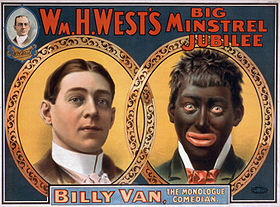Blackface

Blackface merupakan suatu solekan teater yang digunakan pementas bukan kulit putih untuk menggambarkan seorang kulit hitam secara karikatur menghinanya; ia menjadi begitu popular sepanjang abad ke-19 melalui pertunjukan minstrel yang mengalihkan bentuk persembahan yang formal seperti opera kepada tema-tema yang lebih digemari masyarakat umum Amerika Syarikat ketika itu.[1] Seni ini wujud secara berlanjutan sebagai genre teater yang tersendiri sehingga berlakunya Pergerakan Hak Asasi Amerika pada tahun 1960-an.[2]
Bacaan tambahan
- Abbott, Lynn, & Seroff, Doug (2008). Ragged but Right: Black Traveling Shows, "Coon Songs," and the Dark Pathway to Blues and Jazz. Diarkibkan 2009-05-14 di Wayback Machine Jackson: University Press of Mississippi.
- Armstron-De Vreeze, Pamela (1997). "Surviving Zwarte Piet — a Black mother in the Netherlands copes with a racist institution in Dutch culture". Essence magazine. Italic or bold markup not allowed in:
|publisher=(bantuan)[pautan mati] - Bas, Marcel (2013). Zwarte Piet: discriminerend of fascinerend?. Aspekt Uitgeverij. ISBN 9789461534095.CS1 maint: ref=harv (link)
- Chude-Sokei, Louis (2005). The Last Darky: Bert Williams, Black-on-Black Minstrelsy and the African Diaspora. Duke University Press. ISBN 0-8223-3643-X.
- Cockrell, Dale (1997). Demons of Disorder: Early Blackface Minstrels and their World. Cambridge Studies in American Theatre and Drama. ISBN 0-521-56828-5.
- Levinthal, David (1999). Blackface. Arena. ISBN 1-892041-06-5.
- Lhamon, Jr., W.T. (1998). Raising Cain: Blackface Performance from Jim Crow to Hip Hop. Harvard University Press. ISBN 0-674-74711-9.
- Hughes, Langston; Meltzer, Milton (1967). Black Magic: A Pictorial History of Black Entertainers in America. New York: Bonanza Books. ISBN 0-306-80406-9.
- Lott, Eric (1993). Love and Theft: Blackface Minstrelsy and the American Working Class. New York: Oxford University Press. ISBN 0-19-507832-2.CS1 maint: postscript (link) CS1 maint: ref=harv (link)
- Malik, Sarita. "The Black and White Minstrel Show". Museum of Broadcast Communications. Dicapai pada 2007-01-08.
- Rogin, Michael (1998). Blackface, White Noise: Jewish Immigrants in the Hollywood Melting Pot. University of California Press. ISBN 0-520-21380-7.
- Sacks, Howard L., and Sacks, Judith (1993). Way up North in Dixie: A Black Family's Claim to the Confederate Anthem. Washington: Smithsonian Institution Press.
- Sammond, Nicholas (2015). Birth of an Industry: Blackface Minstrelsy and the Rise of American Animation. Durham, NC: Duke University Press.
- Strausbaugh, John (2006). Black Like You: Blackface, Whiteface, Insult and Imitation in American Popular Culture. Jeremy P. Tarcher / Penguin. ISBN 1-58542-498-6.CS1 maint: postscript (link) CS1 maint: ref=harv (link)
- Toll, Robert C. (1974). Blacking Up: The Minstrel Show in Nineteenth-century America. New York: Oxford University Press. ISBN 0-8195-6300-5.CS1 maint: postscript (link) CS1 maint: ref=harv (link)
- Twain, Mark (1924). "XIX, dictated 1906-11-30". Mark Twain's Autobiography. New York: Albert Bigelow Paine. LCCN 24025122.
- Watkins, Mel (1999). On the Real Side: A History of African American Comedy from Slavery to Chris Rock. Chicago, Illinois: Lawrence Hill Books. ISBN 1-55652-351-3.CS1 maint: ref=harv (link)






